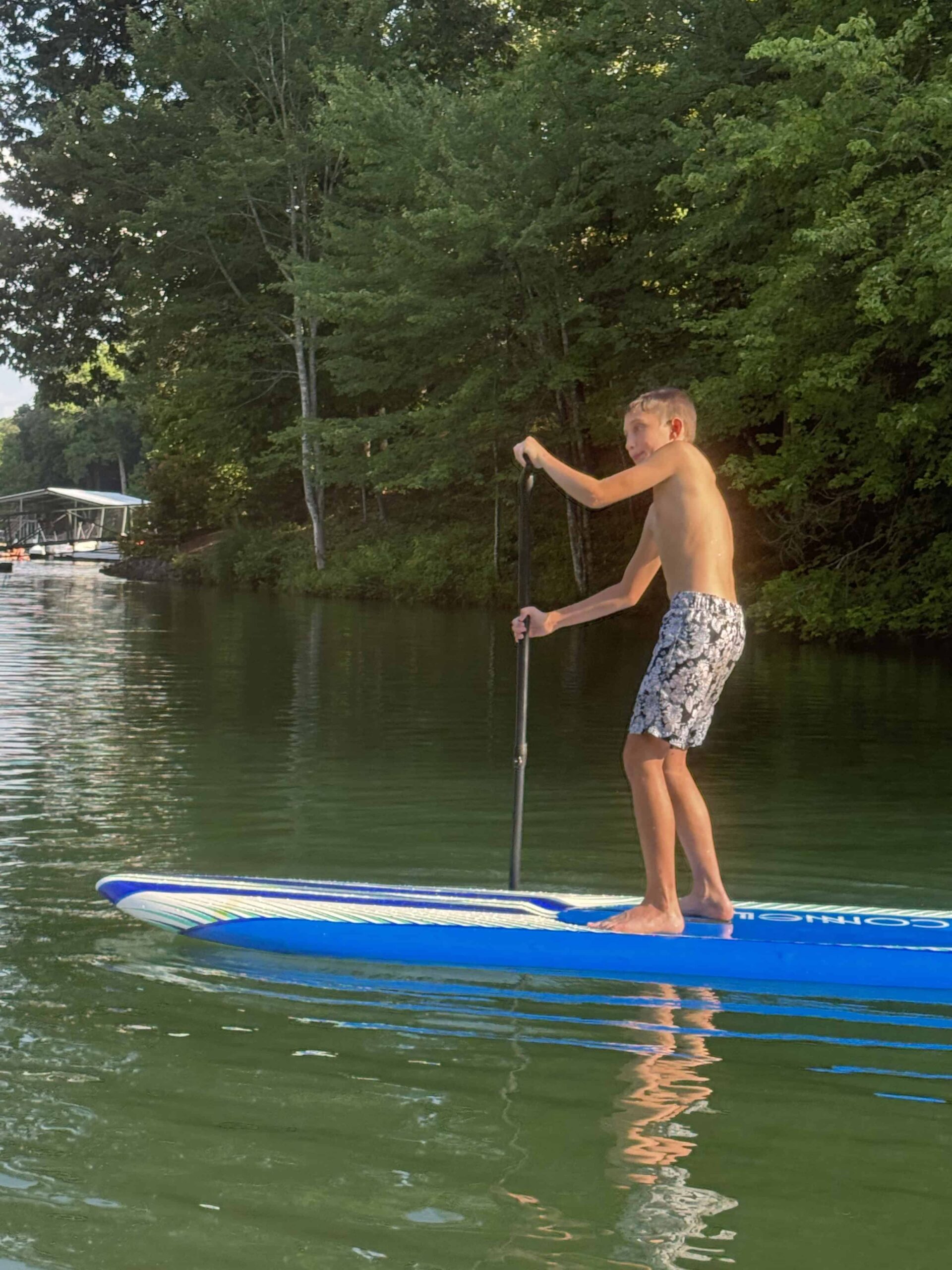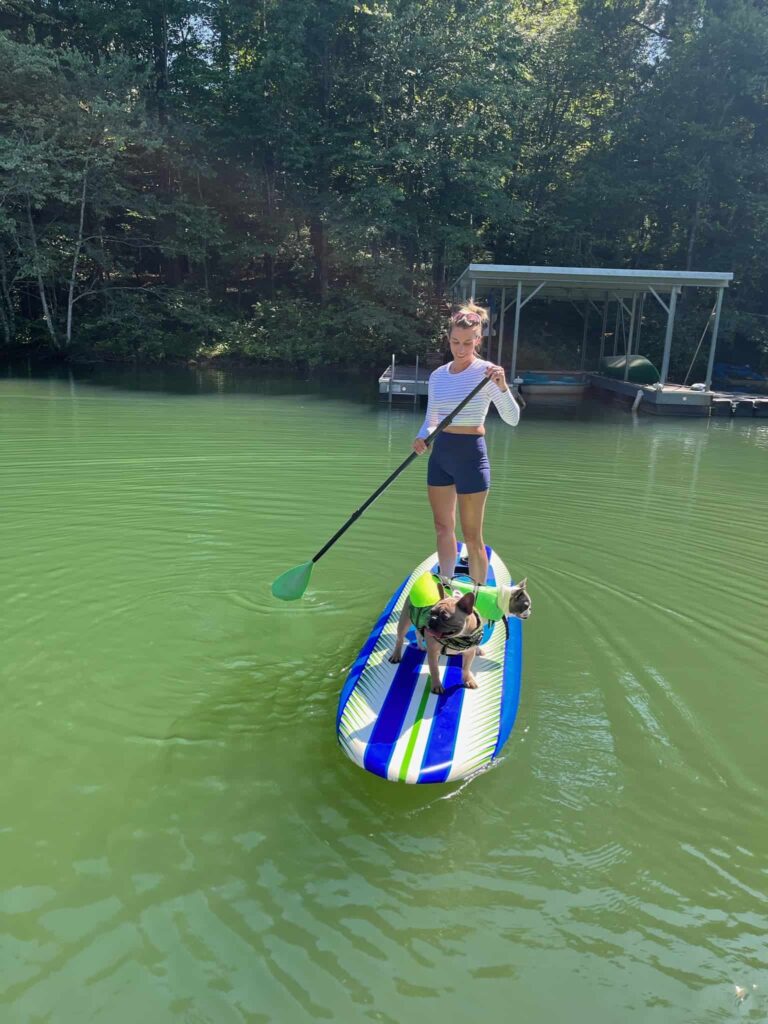Paddleboarding has become one of my favorite pastimes. There’s something so therapeutic about putting on my headphones and paddling around for 45 minutes. Surprisingly, paddleboards are much more stable than you might think. Sure, navigating behind a boat wake can be tricky, and that first time stepping on a paddleboard feels a bit strange. But once you get the hang of it and take your first few strokes, you’ll find your balance.
If you’re feeling wobbly, starting on your knees can help build your confidence. And remember, paddleboarding isn’t just a solo activity. I’ve had plenty of enjoyable paddles with a kid sitting in the front, turning each outing into a memory-making adventure.
Our paddleboard’s adjustable paddle has been a game-changer, allowing everyone in the family—from our kids to my husband and me—to enjoy paddling comfortably.
I’m excited to share some essential standup paddleboarding tips and help you figure out what paddleboard is right for you.
What Stand-Up Paddleboard is Right for Me?
Choosing the right paddleboard can seem daunting, but it boils down to a few key considerations. There are three main types of paddleboards: epoxy, soft-top, and inflatable.
- Epoxy Paddleboards: These boards are great for those with a bit more experience or beginners who are committed to the sport. They are durable and long-lasting but require a way to transport them due to their size and rigidity.
- Soft-top Paddleboards: These are ideal for families and beginners. They have a soft and comfortable surface. Our Connley Soft-Top Paddleboard has moved with us from New York to Texas and now South Carolina, holding up really well. While the soft top can get some pressure dents, it doesn’t affect functionality.
- Inflatable Paddleboards: Perfect for those who need a portable option. They’re easy to transport and store but can be prone to damage from sharp objects or prolonged sun exposure. However, they are still a fantastic option for those who lack space or transportation for a rigid standup paddleboard
We surveyed our favorite Lake Keowee Facebook Group for insights. The consensus is that if you have a way to transport or store an epoxy or soft-top paddleboard, these are preferred for their durability. However, inflatable paddleboards are a great alternative if transporting and storage are an issue.


How to Store Your Stand-Up Paddleboard
Initially, we stored our soft-top paddleboard closer to the house, under the deck. It was heavy and a full workout to bring it down to the dock.
After cleaning up the dock, we installed a rack for the paddleboard, which looks great but can be tricky to maneuver a 10’6” 23lb paddleboard around the railings. We have found the key is to store it with the fin away from the railings and dock. This makes picking it up a bit easier, as the fin won’t get caught in the railing…. Plus you can then maneuver the board to balance on the railing top as you are adjusting your grip. Storing it this way makes maneuvering the board MUCH easier.

Tips for Stand-Up Paddleboarding With Your Dog
Do you know those videos of fit women having a relaxing paddle with their dog? I dream that’s my reality. Up until a year ago, we had two French Bulldogs, a small one (Penelope) and a larger much more wobbly pup Pierre. While I found a way to get both pups on the board, it didn’t last for long….. It was a sight to see for sure
Even though paddling with both pups was a bit of a flop I did have a lot of nice adventures with the smaller dog. Paddling with your dog brings a smile to everyone around, and with the right preparation, it can be a fantastic experience for both you and your furry friend.
Here are my 4 quick tips for paddling with your dog
- Start at a dock or the shore, where it is easy to get the dog on and off the paddle board. It’s going to be a new feeling for them- so ease into it.
- A dog life jacket is essential for safety. I recommend using a life jacket with a top handle, which makes it easy to retrieve your dog from the water if they jump or fall in. We have the VIVAGLORY Ripstop Dog Life Jacket and have used it for years whether the pups were swimming, boating, or attempting to go on the standup paddleboard.
- Bring Treats and Water: Reward your dog with treats for good behavior and ensure they stay hydrated during your paddling adventure.
- Keep Sessions Short: Start with short paddling sessions to build your dog’s confidence and comfort.
Before Purchasing a Stand-Up Paddleboard:
Ask yourself these two questions before purchasing a standup paddleboard:
- Will I be traveling with this board, or will it be stationary (like at your lake house)?
If you plan on taking the Standup Paddleboard on the go, consider this next question:
- Do I have a way to transport a hard 16-foot board without too much hassle?
If you’ll be traveling and don’t have a way to transport a rigid board, go inflatable. Otherwise, an epoxy or soft-top paddleboard is highly recommended by myself and 60+ people who weighed in on our paddleboarding survey
At the end of the day, whatever gets you out on the water is the best choice!






